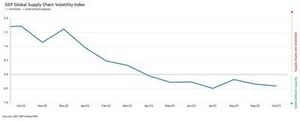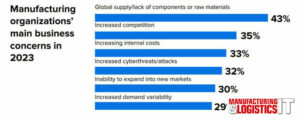Enterprise Resource Planning (ERP) Technology report.
Manufacturing & Logistics IT Magazine spoke with leading representatives from the analyst community about many of the current key talking points and areas of innovation taking place within the world of enterprise resource management (ERP) software and solutions.
 The Enterprise Resource Planning (ERP) space is constantly changing and as mission critical to companies’ business and operational processes as ever. Last year saw the continued growth of cloud applications, together with the rise in uptake of artificial intelligence (AI) and machine learning.
The Enterprise Resource Planning (ERP) space is constantly changing and as mission critical to companies’ business and operational processes as ever. Last year saw the continued growth of cloud applications, together with the rise in uptake of artificial intelligence (AI) and machine learning.
However, let’s begin this report by defining as precisely as possible what ERP is. Passing this task to Capterra, the company explains that ERP is an integrated suite of applications that helps businesses manage key operations such as accounting, sales and purchases, customer relationships, inventory, and human resources. Unlike other solutions that cater to specific workflows, Capterra points out that enterprise resource planning solutions are comprehensive in nature and offer a range of functionalities to address the needs of your entire organisation. ERP software establishes links between departments, streamlining data flow and speeding up the overall decision-making process.
Key benefits
Capterra outlines the key benefits of ERP software:
- Complete visibility of tasks with improved collaboration: ERP software offers complete visibility into important aspects of your business to provide senior management with a single window from which they can monitor both departmental and organisation-wide data. A single enterprise resource planning system facilitates better communication and collaboration between stakeholders from multiple departments, which helps a company’s business and teams to complete tasks efficiently and smoothly.
- More efficient workflows: An enterprise resource planning system reduces the need for repetitive data entry at multiple touchpoints across departments. Once entered, data remains within the system and is accessible by all users. As products or services move along the supply chain, the data is automatically updated for the next department, without any need for additional data entry efforts. This saves time overall and improves workflow efficiency.
Typical features
In terms of typical features of ERP software, Capterra cites the following:
- Inventory management: Keep track of in-house stock quantities and manage reordering to prevent running out of inventory and ensure smooth supply chain operations.
- Financial management: Gather your organisation’s financial data and generate comprehensive reports such as general ledgers, balance sheets, and financial statements.
- HR management: Maintain a complete employee database and manage core HR processes, such as recruiting, hiring, payroll, training, and development.
- Reporting/Analytics: Analyse various workflows, monitor key performance indicators (KPIs), and generate an array of reports to aid compliance and support management discussions.
- Warehouse management: Manage core warehouse operations, such as the movement of inventory, the location of items inside a warehouse, and reordering items.
- CRM: Record customer information, including names and contact numbers, in a centralised, organised database.
Growth in the cloud
 Moving to trends in this technology space, Shawn Windle, founder and managing principal, The ERP Advisors Group, offers some of his perspective. In terms of technological trends, Windle observes that cloud platforms have grown substantially, including the growth of data centres at a global level. “This push for the cloud has resulted in many legacy customers finally taking on migrations to upgrade their systems,” he says. “ERP in the cloud also mitigates the increasing number of cybersecurity attacks across the market, driving vendors to make tremendous global investments in data centres.
Moving to trends in this technology space, Shawn Windle, founder and managing principal, The ERP Advisors Group, offers some of his perspective. In terms of technological trends, Windle observes that cloud platforms have grown substantially, including the growth of data centres at a global level. “This push for the cloud has resulted in many legacy customers finally taking on migrations to upgrade their systems,” he says. “ERP in the cloud also mitigates the increasing number of cybersecurity attacks across the market, driving vendors to make tremendous global investments in data centres.
Customers can rest assured knowing that data centres are nearby, lowering latency and increasing accessibility. All these factors have contributed to the great migration away from legacy technology, especially from legacy organisations across the food and beverage, distribution, manufacturing, non-profit and government industries.
AI and machine learning
Windle believes it is also clear that AI and machine learning are defining the future of innovation, sending us into the next generation of technological offerings. “2022 appeared to be the coming-of-age year for the cloud offerings of a number of vendors, with Oracle Cloud Fusion, SAP’s RISE, and others continuing to grow in prominence,” he explains. “Significant growth opportunities within the mid-sized market have emerged, with smaller-scale vendors continuing to expand and enhance their solutions. This coincides with the growth of micro-vertical solutions across the market, either from emergence or vendor development, such as Salesforce’s automotive solutions release at the end of the year.”
Investment
In terms of investments in ERP and related applications, Windle considers that these were significant in 2022, even with rumblings surrounding the economic downturn. “Many vendors saw astronomical growth between 10 and 30% year-over-year on a quarterly basis, further demonstrating the significant demand for ERP in the market,” he points out. “We observed vendors pouring profits into the advancements of their solutions, either through innovation or acquisition, delivering value to customers.”
On a similar note, Windle explains that Private Equity companies are becoming more active in the ERP space, especially through acquiring niche solutions. “Vendors are following PE’s lead with similar acquisitions, driving growth in niche markets, and maximising their time to market relative to developing the solutions themselves, from the ground up within their own technology stack,” he says. “This is expanding the reach of ERP beyond what we have seen in previous years.” Windle adds that 2022 also saw a rise in strategic relationships between vendors and their customer bases. “Companies like Microsoft are partnering with their customers and developing joint growth efforts,” he points out. “This is unique, with vendors offering deals on their software services in exchange for technological innovation collaborations with their customers. These partnerships heavily encourage mutually beneficial innovations.”
Windle explains that vendors are extending beyond their product offerings by expanding their service programs. “This is evident in SAP’s developer program, Oracle’s filling the financial gap initiative, NetSuite’s consulting programs, and more,” he says. “We also see this commitment in Acumatica’s growing partner program, ensuring the future success of its cloud implementations for customers. In the current market, ERP deals are being won not just by the technology offered but also by the ecosystem of available services.”
Relevant ERP trends
From Capterra’s perspective, key trends in ERP include:
The internet of things (IoT) and artificial intelligence (AI) will transform ERP software: Traditional enterprise resource planning software requires users to manually enter data at various touchpoints in the supply chain. In the coming years, expect more and more modern ERP solutions to include AI and IoT capabilities that automatically collect data from IoT devices attached to tools, vehicles, and equipment. Data such as device location, usage, and performance can be accessed directly by an enterprise resource planning system without manual data entry. From there, AI-enabled enterprise resource planning solutions can provide advanced insights and transparency into new areas of growth, help improve existing workflows and reduce errors.
Mobile ERP is a new buzzword: In almost every area of life and business, users depend on mobile devices. As a result, more and more enterprise resource planning system developers are offering mobile-based ERP solutions and/or mobile functionality through dedicated apps that work with their product. As the rise in mobile workforces continues across all industries, the demand for mobile-based ERP solutions will also increase.
Sourcing
Capterra suggests the following when looking to source and ERP system:
- Establish a clear ERP strategy before investing in ERP software: ERP software is a broad solution that often includes various modules and integrated services for multiple departments fused together in one system. Most businesses lack a clear enterprise resource planning system implementation strategy, and either develop one through tactical decisions or rely on their IT team to define ERP requirements without considering the needs of other stakeholders. This can lead to poor enterprise resource planning system implementation or investing in software that is too technical and complex for your employees to use. To avoid this, consult stakeholders from all relevant departments while designing your ERP strategy, and build a software shortlist that meets those needs.
- Industry-specific ERP solutions vs. generic solutions: These days, many vendors offer industry-specific enterprise resource planning solutions (e.g., construction ERP software, manufacturing ERP software, apparel ERP software, education ERP software). If possible, give priority to enterprise resource planning system solutions that cater to your particular industry over investing in a generic solution that can be customised for any industry. A specific solution can help you meet industry standards and execute workflows using industry-approved templates that help minimise failure rate.
Hybrid and multi-cloud environments
From a more general enterprise IT perspective, Frost & Sullivan makes the point that more organisations now support hybrid and multi-cloud environments as both workers and workloads expand to more locations. It adds that bring-your-own-device policies enable workers to access corporate applications and services from multiple places and platforms, and modern development tools decouple apps and services from the infrastructure that they run on, allowing flexible movement according to business needs. Frost & Sullivan explains that IT departments have adopted a variety of infrastructures and platforms on corporate premises and the cloud to accommodate these changes, creating the corporate hybrid cloud. Simultaneously, businesses are evaluating their infrastructure needs more critically and making more strategic choices among the available options, sometimes using multiple public cloud providers, or a multi-cloud environment.
Frost & Sullivan’s white paper, Leveraging Strategic Hybrid Cloud in Enterprise IT, discusses how current knowledge gaps in cloud technologies open opportunities for new services, tips for gaining stakeholder support, and hybrid and multi-cloud best practices for enterprises. Its 2021 research finds that 41% of businesses globally have implemented a hybrid cloud, while 36% use a multicloud environment. Some businesses use a hybrid cloud platform to introduce visibility, control, advanced data protection and security, and analytics. Others, however, struggle to manage their assets in a complete environment. Moreover, many organisations can’t get to the ideal hybrid scenario because of complexity, team structures, or organisational challenges, such as difficulty in holistically managing policies, enforcement, and security across vendors.
 “Broad, comprehensive enterprise digital transformation introduces new business risks,” says Toph Whitmore, industry director, Frost & Sullivan. “The to-be-managed enabling technology fabric now extends into the cloud and widens to encompass work-from-anywhere connectivity. IT leaders must balance organisational cloud aspiration with operational realities, a dichotomy that complicates security delivery, efficacy, and management. Securing hybrid- and multi-cloud environments can require IT leaders to integrate solutions to mitigate risk.”
“Broad, comprehensive enterprise digital transformation introduces new business risks,” says Toph Whitmore, industry director, Frost & Sullivan. “The to-be-managed enabling technology fabric now extends into the cloud and widens to encompass work-from-anywhere connectivity. IT leaders must balance organisational cloud aspiration with operational realities, a dichotomy that complicates security delivery, efficacy, and management. Securing hybrid- and multi-cloud environments can require IT leaders to integrate solutions to mitigate risk.”
Cloud migration unlocks organisational data value and allows access to modern services that provide softer benefits, like operational efficiencies or improved regulatory compliance. Hybrid and multi-cloud strategies can:
- Help against cloud lock-in to optimise costs continually.
- Enable rapid flexibility to gain tremendous value.
- Improve cost optimisation, uptime, and governance.
- Mitigate security and compliance risk.
- Implement data protection strategies and optimise ROI.
Moving away from on-premise
 Continuing the cloud theme, Bryan Ball, vice president and group director, supply chain, ERP and GSM research practices, Aberdeen Strategy & Research, provides some key findings from a recent Aberdeen Strategy & Research survey that looks at adoption rates of cloud ERP. The research shows how companies have largely moved away from ERP on-premise to the cloud. Approximately 90% of companies now have some form of cloud and 10% have on-premise, and a considerable number of companies that are still using on-premise use a preconfigured device – therefore they have a blend of online software and hardware. However, for large corporations on premise usage stands at about 6%, pointing to the fact that the vast majority have moved to the cloud – whether public cloud or a private cloud.
Continuing the cloud theme, Bryan Ball, vice president and group director, supply chain, ERP and GSM research practices, Aberdeen Strategy & Research, provides some key findings from a recent Aberdeen Strategy & Research survey that looks at adoption rates of cloud ERP. The research shows how companies have largely moved away from ERP on-premise to the cloud. Approximately 90% of companies now have some form of cloud and 10% have on-premise, and a considerable number of companies that are still using on-premise use a preconfigured device – therefore they have a blend of online software and hardware. However, for large corporations on premise usage stands at about 6%, pointing to the fact that the vast majority have moved to the cloud – whether public cloud or a private cloud.
Interestingly, the survey also found that 83% of best-in-class companies questioned only utilise the software for ERP-based financials. Some 70% have disparate solutions, some have a solution developed in-house while some still rely on spreadsheets. “If you look at all the companies surveyed, about 80% are using ERP versus some other way of running the business,” says Ball. “Some 90% have moved to the cloud for whatever they’re doing and the vast majority of companies are using ERP.”
Competitive advantage
Ball adds that because more companies are now utilising cloud ERP, the cloud doesn’t necessarily provide a competitive advantage because it has become more commoditised. Ball did, however, find two areas that do give companies a substantial edge. One of these relates to the fact that many best-in-class companies are very focused on modernising their technology infrastructure and their applications by a significant percentage compared with their competition.
“When we isolate that variable and look at what they are doing versus what the other companies are doing that’s where some of the capability differences jump out,” explains Ball. “They are just stronger in every way, having standardised procedures, the integrated system of record, the ability to report and manage compliance activities, interoperability, collaborating with customers and so on. So, we found there were significant differences when we isolated that one variable. Essentially, if companies have the cloud in place, they can leverage the technology to do more with it.”
Ball also makes the point that when companies initially move to the cloud, even though they are utilising a cloud structure that doesn’t mean all their applications had been designed for the cloud. “They may have a user interface to get to the application, but it still runs like it did on a mainframe,” he says. “It may be in a private cloud, but it hasn’t been designed to leverage all the benefits of the cloud. It still works but you don’t get a lot of improvement in that particular application. The application could be, for example, supply chain, a procurement module, a quality control module or something else that may not be the most important type of functionality to the company in question.”
Ball adds that many of these applications not specifically designed for the cloud may have been acquired through the acquisition of another company. “That means you need to think about how to integrate them within your own system or replace these systems,” he says. “So, you can either have these acquired applications roll up to the ‘mothership’ integration wise or change everything you’re doing. However, it may not be worth the time and expense – that is to say, you may just need the transaction and profitability information and so it might make more sense just to keep these applications as they are.
We could be talking about software used in a sales office or small distribution point. In other words, it may not be a manufacturing plant or distribution facility on a large scale. Even if we’re talking about something like an insurance company there may be multiple offices and branches in different locations, and in those types of cases a system like QuickBooks works fine for its purpose. Why change it? So, although many companies, particularly the best-in-class companies, are looking to modernise their systems and processes, it might not be necessary in all cases. You might instead want to buy a best-of-breed supply chain solution and use that in lieu of the one that your ERP currently has if supply chain wasn’t such a key focus when you sourced the ERP. Now, supply chain is everything.”
 Graham Upton, technology & innovation director & chief architect, intelligent industry, Capgemini, considers that AI is definitely one of the key talking points within the world of ERP and wider afield. “It could also be referred to as machine learning, which is really part of AI manufacturing and we’ve been using this for several years now,” he says. “However, we are now getting much more data, and this data can be used to better inform the business about what is happening – whether it’s the water industry doing predictive flood control, or in aerospace and automotive you can use it to predict whether your machines are about to fail and so on. All of this is really positive because it helps to improve business processes.”
Graham Upton, technology & innovation director & chief architect, intelligent industry, Capgemini, considers that AI is definitely one of the key talking points within the world of ERP and wider afield. “It could also be referred to as machine learning, which is really part of AI manufacturing and we’ve been using this for several years now,” he says. “However, we are now getting much more data, and this data can be used to better inform the business about what is happening – whether it’s the water industry doing predictive flood control, or in aerospace and automotive you can use it to predict whether your machines are about to fail and so on. All of this is really positive because it helps to improve business processes.”
AI and design
Another side of AI that Upton is seeing is how AI could be used in a design process. “For example, if a company is designing something today it will likely be reliant on the knowledge of its engineers or architects,” he explains. “However, I think AI will increasingly have a big impact here – someone will try something out, and if it doesn’t quite work do a stress calculation and go back recalculate it. In fact, that is already automated in some of the ERP systems today, but AI is going to accelerate the speed of this process, especially around lifecycle.
So, if the initial requirements are set to design a particular product maybe in a certain material to satisfy a customer’s requirements, whereas before you would have tools to iterate this it would take longer. It will be so much quicker with AI because it will keep iterating and it will do it in a fraction of the time. So, the worry is companies won’t need as many engineers, although the engineers could maybe do more designs in a shorter timeframe.”
Upton is also seeing two main specific ERP trends. “One is we are seeing that ERP systems are rapidly growing and expanding in their influence these days,” he says. “If you take SAP, we are seeing its tentacles already spreading. ERP modules are being added that do things that it couldn’t do before in terms of the link to the supply chain, the link to manufacturing etc. SAP can now also be more rapidly updated because those types of modules are already part of the system.” Upton is also witnessing more integration of Internet of Things (IoT) technology to automatically determine what’s happening and then auto update the ERP systems. “That’s one of the biggest changes,” he says.
Integration challenges
 On the topic of integration, Bill Baumann, director of expert witness services, Panorama Consulting Solutions, considers that when a company invests in enterprise software, it wants to ensure its employees can easily access and use the software from anywhere. This, he says, expands beyond the company’s in-office workforce and includes remote or on-site personnel. “Decades ago, this issue alone would have presented its fair share of challenges,” adds Baumann. “Today, however, most employees are equipped with at least some type of mobile device, whether a company-issued phone or one of their own. Yet, enterprise software mobile integration challenges still exist, though the challenges are manageable.” Baumann shares some of the issues companies may encounter when seeking to achieve seamless adoption of mobile integration and what to prioritise.
On the topic of integration, Bill Baumann, director of expert witness services, Panorama Consulting Solutions, considers that when a company invests in enterprise software, it wants to ensure its employees can easily access and use the software from anywhere. This, he says, expands beyond the company’s in-office workforce and includes remote or on-site personnel. “Decades ago, this issue alone would have presented its fair share of challenges,” adds Baumann. “Today, however, most employees are equipped with at least some type of mobile device, whether a company-issued phone or one of their own. Yet, enterprise software mobile integration challenges still exist, though the challenges are manageable.” Baumann shares some of the issues companies may encounter when seeking to achieve seamless adoption of mobile integration and what to prioritise.
1. Develop a mobile strategy
There are stages of mobile maturity. Before you begin the software integration stage, you may want to research software experts and hire one to help you understand where your organisation lies. Otherwise, you could proceed without a concrete goal in place.
At the very basic level, companies can adapt their current, on-premise strategies to a smaller screen. This is where most organisations start, but the goal shouldn’t be to stay here. As they progress, companies will enter the second stage. This is when a company takes a ‘mobile-first’ approach, looking at how its business can leverage the unique features of mobility to its advantage. At the third stage, business leaders begin to look at how mobile can help them improve the customer experience and attract future buyers. When a business reaches the fourth stage, it has reached full maturity. Here, it is looking for ways to use mobile to develop new products, services, business models and revenue streams.
A company’s current position on this spectrum will determine how its business should approach its mobile strategy. “There’s no right or wrong place to start, but you do need some kind of plan in place before you proceed,” says Baumann. “Often, companies try to approach mobility as a piecemeal process, which can lead to more complications down the road.”
2. Ensure data security
Any time a company’s enterprise software data leaves the organisation, it’s at risk. This is especially the case if it is being accessed, shared and stored on a mobile device. “While you could task your in-house IT team with building custom code, this can be an incredibly time-consuming process,” stresses Baumann. “Depending on the extent of your data, it could take weeks and monopolise their time.”
One alternative he cites is to outsource the task, hiring a software development expert to take the reins. “You can also use an application programming interface (API) management platform. These solutions are designed to facilitate secure mobile integration in a short timeframe, without the need for additional coding. APIs enable mobile apps to access data and communicate with one another, so they can share services. An API management platform helps organisations centralise their approach to API control, ensuring each one is secure, consumable and aligned with required standards.”
3. Plan for scalability
Baumann considers that it is an achievement for a company to integrate its existing business systems with the mobile apps that its employees are using today. “Yet, have you given much thought to the approach you’ll take in the future?” he asks. “When planning for mobile integration, it helps to think about your strategy five or even ten years into the future. The only issue? It’s nearly impossible to plan for all the new types of systems, devices and platforms that will exist at that time.”
Baumann adds that as the Internet of Things (IoT) continues to evolve, the industry is constantly expanding and adding new tech solutions. “As such, companies need the ability to quickly and easily change their app database or add new ones,” he says. “This is the only way they’ll be able to stay competitive and take advantage of new technologies as they emerge. In short, when researching potential API management solutions with your software expert, ask about future scalability.
4. Optimise employee adoption
After spending time and money on enterprise software integration, Baumann comments that companies want to encourage their workforce to use the apps at their fingertips. “Ultimately, this will depend on the user experience that each app provides,” he says “If it’s clunky and difficult to navigate, they’ll be less inclined to use the tools, even if they need the data.”
Ideally, adds Baumann, the experience will be smooth and seamless, which he believes is another reason why custom coding isn’t usually ideal. “While it might technically get the job done, it can create an intricate web of connections that can be nearly impossible for the average user to navigate,” he explains. “You don’t want your technology expert to be the only one who knows how to use the apps. When enterprise systems are easy to access and understand, it also helps your employees embrace the change with less resistance. Even if they’re used to being on their device all day, there will be a period of transition as they learn the new platforms and this process should be as painless as possible.”
If a company plans to add more apps in the future, Baumann believes it is important to simplify and streamline now. “If your mobile app backend is simply and efficiently connected to your enterprise data via an API platform, you can optimise the user experience,” he says. “With fewer roadblocks to navigate, adoption rates should rise.”

Smart step
Baumann concludes that integrating your enterprise software with your mobile solutions is a smart step. “It allows your workforce to leverage your ERP, CRM, or SCM system from anywhere, at any time,” he explains. “As you begin to plan this initiative, consider the operational and technical challenges. If you don’t prepare for enterprise software mobile integration challenges, you might experience an enterprise software nightmare or an ERP failure.”
Vendor analysis
Windle makes the following vendor predictions. “Acumatica has gained significant traction, providing great innovation to the market,” he says. “Acumatica’s partnership ecosystem is continuing to grow and provide great support to customers. I expect to continue to see big growth from Acumatica in the coming year.” Windle observes that Epicor has a number of proven products on the market that it is continuing to enhance, especially in terms of its micro-vertical focuses. He adds that Epicor continues to purchase best-of-breed solutions to extend its product offerings. “Epicor is continuing to bring in new products that will allow the company to effectively contribute to the growth of its clients.”
In Windle’s view. IFS is leaning towards a micro-vertical focused approach within the Enterprise Asset Management space, with continued expansion into the North American market. “It is a very successful firm internationally and we expect IFS to continue to enhance its EAM solutions and pick up market share,” he says.
Moving to Infor, Windle makes the point that the company is one of the few major software vendors privately held, making a huge difference in its market position. “Infor is still investing in its on-premises solutions and its CloudSuite solutions because it understands that some customers demand incremental, less drastic change than uplifting their entire platform,” he says. Windle adds that Infor continues to acquire customers, believing the company has a solid, multi-pronged strategy that demonstrates the next evolution of the cloud.
Windle observes that Microsoft has simplified its pricing strategy on the software side in a very straightforward way that is extremely beneficial to the customer. “Microsoft is a household name that continues to garner support from long-time users who want to continue their growth with products like Business Central for smaller-scale enterprises and Finance & Supply Chain Management for larger enterprises. Microsoft is very well positioned and has advanced its partnership channel, allowing it to extend its value to customers during 2023.”
NetSuite’s growth continues to be astronomical, especially in the mid-market,” according to Windle. “NetSuite has further developed its PE portfolio, continuing to assist companies in that space with their digital transformations. We foresee NetSuite continuing its growth trajectory during 2023.” Oracle Cloud Fusion has picked up significant market share. Windle comments: “We do see Oracle Cloud Fusion becoming more and more viable for the legacy Oracle customer, delivering an expansive solution for their growth opportunities.” OCI’s continued expansion will also deliver necessary cybersecurity measures for customers in 2023 and beyond.”
Windle points out that Sage has an extensive portfolio of legacy clients that it is looking to upgrade to cloud offerings. “Sage Intacct is especially focused on the delivery of value within the Nonprofit space,” he says. “Sage Intacct is a really good product for evolving companies and will continue to focus on the innovation of their offerings.” Salesforce had a major year in 2022, surpassing SAP as the largest software vendor in the world. “There are great innovations coming from Salesforce, with heavy investments continuing to be put into new products and their partnership channel,” says Windle.
In recent years, Windle observes that SAP has begun to move down market, delivering solutions within the SMB space. During this year, Windle believes SAP will continue to simplify the implementation process for customers to deliver great value efficiently. He adds that international solutions, like SAP, have significant resources to contribute to the success of clients. In terms of Unit4’s developments, Windle comments that the company is carefully honing its North American strategy in the professional services, non-profit and human capital markets. “Unit4’s strong understanding of global markets and implementations is a differentiator and will contribute to the company’s success during 2023,” says Windle.
Workday continues to deliver value within the human capital management space, according to Windle, with innovations and opportunities growing within its financial offerings. Windle believes that during this year Workday will dial in the incremental value of its solutions, differentiating it from the competition in terms of functionality.
Windle concludes that the next 10 years of ERP innovation are going to make the past 50 look like nothing in comparison, with innovative solutions emerging across the market and the prominence of AI and machine learning drastically expanding what technology can do. “ERP vendors are experiencing unbelievable growth, providing great resources to deliver revolutionary technological enhancements,” he concludes.

Collaboration
In terms of future trends in general, Upton is seeing an increase in links to technologies such as robotics. “It is interesting to witness how companies can now use this type of technology and connectivity in areas including nuclear decommissioning – in other words, quite challenging environments.” He adds that IoT and connected devices are increasingly being used to better control robotic automation. “This is becoming more prevalent in automotive and it’s starting to spread out in other areas,” he says.
Upton also believes we will start to see more developments in terms of cloud and multi-cloud. “Previously, and you still find it this today, a lot of businesses tend to go with one of the hyper scalers and are kind of weathered to Microsoft, Amazons or Google,” he says. “Increasingly, however, there is a need to collaborate more and be able to operate in a multi cloud environment – even within one business.” Upton also anticipates ever greater use of AI and machine learning. “This trend is already here, but I think that will expand further very quickly.”
- SEO Powered Content & PR Distribution. Get Amplified Today.
- PlatoData.Network Vertical Generative Ai. Empower Yourself. Access Here.
- PlatoAiStream. Web3 Intelligence. Knowledge Amplified. Access Here.
- PlatoESG. Automotive / EVs, Carbon, CleanTech, Energy, Environment, Solar, Waste Management. Access Here.
- BlockOffsets. Modernizing Environmental Offset Ownership. Access Here.
- Source: https://www.logisticsit.com/articles/2023/06/28/the-move-from-legacy-to-high-tech
- :has
- :is
- :not
- :where
- $UP
- 10
- 2021
- 2022
- 2023
- 50
- a
- ability
- Able
- About
- accelerate
- access
- accessed
- accessibility
- accessible
- accommodate
- According
- Accounting
- Achieve
- achievement
- acquire
- acquired
- acquiring
- acquisition
- acquisitions
- across
- active
- activities
- adapt
- add
- added
- adding
- Additional
- address
- Adds
- adopted
- Adoption
- advanced
- advancements
- ADvantage
- advisors
- Aerospace
- against
- ago
- AI
- Aid
- aligned
- All
- allow
- Allowing
- allows
- alone
- along
- already
- also
- alternative
- Although
- American
- among
- an
- analyse
- analyst
- analytics
- and
- Another
- any
- anywhere
- api
- APIs
- app
- apparel
- appeared
- Application
- applications
- approach
- approximately
- apps
- ARE
- AREA
- areas
- around
- Array
- artificial
- artificial intelligence
- Artificial intelligence (AI)
- AS
- aspects
- aspiration
- asset
- asset management
- Assets
- assist
- assured
- At
- Attacks
- attract
- auto
- Automated
- automatically
- Automation
- automotive
- available
- average
- avoid
- away
- back
- Backend
- Balance
- balance sheets
- ball
- basic
- basis
- BE
- because
- become
- becoming
- been
- before
- begin
- begun
- being
- believes
- believing
- beneficial
- benefits
- BEST
- best practices
- Better
- between
- BEVERAGE
- Beyond
- Big
- Biggest
- Bill
- Blend
- both
- branches
- bring
- broad
- Bryan
- build
- Building
- business
- business processes
- businesses
- but
- buy
- buyers
- buzzword
- by
- CAN
- capabilities
- capability
- Capgemini
- capital
- Capital Markets
- carefully
- case
- cases
- cater
- central
- centralised
- centres
- certain
- chain
- challenges
- challenging
- change
- Changes
- changing
- Channel
- chief
- choices
- clear
- clients
- Cloud
- cloud applications
- Cloud Platform
- CO
- code
- Coding
- collaborate
- collaborating
- collaboration
- collaborations
- collect
- coming
- comments
- commitment
- communicate
- Communication
- community
- Companies
- company
- Company’s
- compared
- comparison
- competition
- competitive
- complete
- complex
- complexity
- compliance
- comprehensive
- connected
- connected devices
- Connections
- Connectivity
- Consider
- considerable
- considering
- considers
- constantly
- construction
- consulting
- contact
- continually
- continue
- continued
- continues
- continuing
- contribute
- contributed
- control
- Core
- Corporate
- Corporations
- Cost
- Costs
- could
- couldn
- create
- Creating
- critical
- CRM
- Current
- Currently
- custom
- customer
- customer experience
- Customers
- Cybersecurity
- data
- data centres
- data entry
- data protection
- Database
- day
- Days
- Deals
- Decision Making
- decisions
- dedicated
- defining
- definitely
- deliver
- delivering
- delivery
- Demand
- demonstrates
- demonstrating
- Department
- departments
- Design
- design process
- designed
- designing
- designs
- Determine
- develop
- developed
- Developer
- developers
- developing
- Development
- development tools
- developments
- device
- Devices
- DID
- difference
- differences
- different
- differentiator
- difficult
- Difficulty
- digital
- Digital Transformation
- directly
- Director
- discussions
- disparate
- distribution
- do
- doesn
- Doesn’t
- doing
- don
- done
- Dont
- down
- DOWNTURN
- drastically
- driving
- during
- e
- each
- easily
- easy
- Economic
- economic downturn
- ecosystem
- Edge
- Education
- effectively
- efficacy
- efficiencies
- efficiency
- efficient
- efficiently
- efforts
- either
- else
- embrace
- emerge
- emerged
- emergence
- emerging
- Employee
- employees
- enable
- enabling
- encompass
- encounter
- encourage
- end
- enforcement
- Engineers
- enhance
- enhancements
- ensure
- ensuring
- Enter
- entered
- Enterprise
- enterprise software
- enterprises
- Entire
- entry
- Environment
- environments
- equipment
- equipped
- equity
- ERP
- ERP Software
- Errors
- especially
- essentially
- establishes
- etc
- Ether (ETH)
- evaluating
- Even
- EVER
- Every
- everything
- evident
- evolution
- evolve
- evolving
- example
- exchange
- execute
- exist
- existing
- Expand
- expanding
- expands
- expansion
- expansive
- expect
- experience
- experiencing
- expert
- experts
- Explains
- extend
- extending
- extends
- extensive
- extent
- extremely
- fabric
- facilitate
- facilitates
- Facility
- fact
- factors
- FAIL
- Failure
- fair
- Features
- few
- fewer
- filling
- Finally
- finance
- financial
- financial data
- financials
- Find
- findings
- finds
- fine
- Firm
- five
- Flexibility
- flexible
- flood
- flow
- Focus
- focused
- focuses
- following
- food
- For
- form
- found
- founder
- Fourth
- fraction
- from
- Frost
- Frost & Sullivan
- full
- functionalities
- functionality
- further
- fusion
- future
- Gain
- gained
- gaining
- gap
- gaps
- gather
- General
- generate
- generation
- get
- getting
- Give
- given
- Global
- global markets
- Globally
- Go
- goal
- going
- good
- governance
- Government
- great
- greater
- Ground
- Group
- Grow
- Growing
- grown
- Growth
- had
- Happening
- Hardware
- Have
- having
- he
- heavily
- heavy
- Held
- help
- helps
- here
- hire
- Hiring
- his
- household
- How
- How To
- However
- hr
- HTTPS
- huge
- human
- Human Resources
- Hybrid
- hybrid cloud
- i
- ideal
- if
- Impact
- implementation
- implemented
- important
- impossible
- improve
- improved
- improvement
- improves
- in
- In other
- Inclined
- include
- includes
- Including
- Increase
- increasing
- increasingly
- incredibly
- Indicators
- industries
- industry
- industry standards
- industry-specific
- influence
- inform
- information
- Infrastructure
- infrastructures
- initial
- initially
- Initiative
- Innovation
- innovations
- innovative
- inside
- insights
- instead
- insurance
- integrate
- integrated
- Integrating
- integration
- Intelligence
- Intelligent
- interesting
- Interface
- International
- internationally
- Internet
- internet of things
- Interoperability
- into
- introduce
- Introduces
- inventory
- investing
- Investments
- Invests
- iot
- iot devices
- isolated
- issue
- issues
- IT
- items
- ITS
- Job
- joint
- jpg
- jump
- just
- Keep
- Key
- Kind
- Knowing
- knowledge
- Lack
- large
- largely
- larger
- largest
- Last
- Last Year
- Latency
- lead
- leaders
- leading
- LEARN
- learning
- least
- ledgers
- Legacy
- less
- Level
- Leverage
- lies
- Life
- lifecycle
- like
- likely
- LINK
- links
- location
- locations
- logistics
- longer
- Look
- look like
- looking
- LOOKS
- Lot
- lowering
- machine
- machine learning
- Machines
- magazine
- Main
- maintain
- major
- Majority
- make
- MAKES
- Making
- manage
- management
- managing
- manual
- manually
- manufacturing
- many
- Market
- Markets
- material
- maturity
- maximising
- May..
- mean
- means
- measures
- Meet
- Meets
- Microsoft
- mid-market
- might
- migration
- minimise
- Mission
- Mitigate
- Mobile
- Mobile app
- mobile device
- mobile devices
- mobile-apps
- mobility
- models
- Modern
- module
- Modules
- money
- Monitor
- more
- Moreover
- most
- move
- moved
- movement
- much
- multi
- multiple
- must
- mutually
- name
- names
- Nature
- Navigate
- nearly
- necessarily
- necessary
- Need
- needs
- New
- new products
- New Tech
- New technologies
- next
- no
- non-profit
- Nonprofit
- North
- nothing
- now
- nuclear
- number
- numbers
- observed
- Observes
- of
- offer
- offered
- offering
- Offerings
- Offers
- Office
- offices
- often
- on
- once
- ONE
- ones
- online
- only
- open
- operate
- operational
- Operations
- opportunities
- optimise
- Options
- or
- oracle
- organisation
- Organisations
- Other
- Others
- otherwise
- out
- outlines
- outsource
- over
- overall
- own
- P&E
- Paper
- part
- particular
- particularly
- partner
- partnering
- Partnership
- partnerships
- Passing
- past
- Payroll
- percentage
- performance
- period
- Personnel
- perspective
- phone
- pick
- picked
- Place
- Places
- plan
- planning
- plans
- platform
- Platforms
- plato
- Plato Data Intelligence
- PlatoData
- Point
- points
- policies
- poor
- portfolio
- position
- positioned
- positive
- possible
- potential
- practices
- precisely
- predict
- Predictions
- Prepare
- presented
- president
- prevalent
- prevent
- previous
- pricing
- Principal
- prioritise
- priority
- private
- Private Equity
- procedures
- process
- processes
- procurement
- Product
- Products
- professional
- profitability
- profits
- Program
- Programming
- Programs
- Progress
- prominence
- protection
- proven
- provide
- providers
- provides
- providing
- public
- Public cloud
- purchase
- purchases
- purpose
- Push
- put
- quality
- question
- Questioned
- Quickbooks
- quicker
- quickly
- range
- rapid
- rapidly
- Rate
- Rates
- RE
- reach
- reached
- Reaches
- realities
- really
- reason
- recent
- record
- recruiting
- reduce
- reduces
- referred
- regulatory
- Regulatory Compliance
- related
- Relationships
- relative
- release
- relevant
- rely
- remains
- remote
- repetitive
- replace
- report
- Reports
- Representatives
- require
- required
- Requirements
- requires
- research
- Resistance
- resource
- Resources
- REST
- result
- resulted
- revenue
- revolutionary
- right
- Rise
- Risk
- risks
- road
- roadblocks
- robotics
- ROI
- Roll
- Run
- running
- s
- sales
- salesforce
- sap
- saw
- say
- says
- Scalability
- Scale
- scenario
- Screen
- seamless
- Second
- secure
- securing
- security
- see
- seeing
- seeking
- seen
- sending
- senior
- sense
- service
- Services
- set
- several
- Share
- shared
- Shares
- shawn
- Short
- should
- Shows
- side
- significant
- similar
- simplified
- simplify
- simply
- simultaneously
- single
- small
- smaller
- smart
- SMB
- smooth
- smoothly
- So
- Software
- software development
- solid
- solution
- Solutions
- some
- Someone
- something
- Source
- sourced
- Space
- specific
- specifically
- Spectrum
- speed
- Spending
- spread
- Spreading
- stack
- Stage
- stages
- stakeholder
- stakeholders
- standards
- stands
- start
- Starting
- statements
- stay
- Step
- Still
- stock
- stored
- straightforward
- Strategic
- strategies
- Strategy
- streamline
- streamlining
- streams
- stress
- strong
- stronger
- structure
- Struggle
- substantial
- substantially
- success
- successful
- such
- Suggests
- suite
- Sullivan
- supply
- supply chain
- supply chain management
- support
- Surrounding
- Survey
- surveyed
- system
- system of record
- Systems
- tactical
- Take
- takes
- taking
- talking
- Task
- tasks
- team
- teams
- tech
- Technical
- technically
- technological
- Technologies
- Technology
- technology infrastructure
- templates
- ten
- terms
- than
- that
- The
- The Future
- the world
- their
- Them
- theme
- themselves
- then
- There.
- therefore
- These
- they
- things
- think
- Third
- this
- this year
- those
- though?
- thought
- Through
- time
- time-consuming
- timeframe
- tips
- to
- today
- together
- too
- tools
- topic
- towards
- track
- traction
- traditional
- Training
- trajectory
- transaction
- Transform
- Transformation
- transformations
- transition
- Transparency
- tremendous
- Trend
- Trends
- try
- two
- type
- types
- typical
- understand
- understanding
- understands
- unique
- unique features
- unlike
- unlocks
- Update
- updated
- upgrade
- uptime
- us
- Usage
- use
- used
- User
- User Experience
- User Interface
- users
- using
- usually
- value
- variety
- various
- Vast
- Ve
- Vehicles
- vendor
- vendors
- Versus
- very
- via
- viable
- vice
- Vice President
- View
- visibility
- vs
- want
- wants
- Warehouse
- Warehouse Operations
- Water
- Way..
- ways
- we
- web
- Weeks
- WELL
- were
- What
- What is
- whatever
- when
- whereas
- whether
- which
- while
- white
- white paper
- WHO
- why
- wider
- will
- WISE
- with
- within
- without
- witness
- witnessing
- Won
- words
- Work
- workers
- workflow
- workflows
- Workforce
- works
- world
- worry
- worth
- would
- Wrong
- year
- years
- yet
- you
- Your
- zephyrnet












